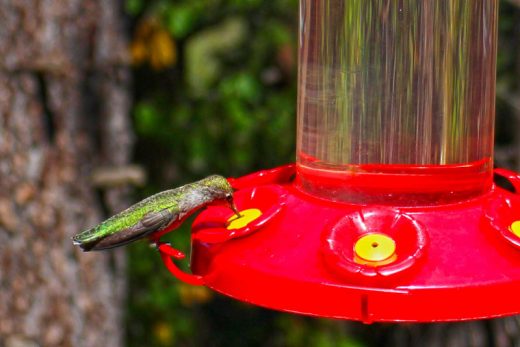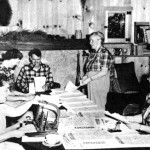
As winter approaches, you may be wondering when you should take your hummingbird feeder down. The answer may surprise you. In winter, hummingbird feeders should just be taken down to clean and refill, then it’s a good idea to put them right back up again.
The biggest hummingbird myth is that leaving feeders up in the winter will harm our tiny-winged friends as it could prevent them from migrating when they should. It’s simply not true.
The experts at the Cornell Lab of Ornithology and the Audubon Society agree that hummingbirds who migrate do so based on their internal clock, not on the availability of hummingbird feeders. As the days shorten, many hummingbirds head for warmer pastures but, luckily for us, plenty choose to winter in Idyllwild. When the temperatures plummet, they need the nectar in our feeders more than ever.
Among hummingbird experts and enthusiasts, there’s a difference of opinion on whether or not changing the nectar recipe is a good idea during winter. The recommended year-round recipe is 1/4 cup sugar to 1 cup of water, or 1:4. The Cornell Lab advises that during colder weather, increasing the sugar to 1/3 cup per cup of water (1:3) will help hummingbirds.
Others disagree and insist that sticking with the standard ratio is healthier for the birds. Whose advice should you take? Perhaps another factor will play a role in your decision — freezing.
Hummingbird nectar in the 1:4 ratio will begin freezing when temperatures drop to 27 degrees, preventing the hungry birds from being able to use your feeder. Following the 1:3 recipe is one way to slightly lower that freezing point.
Fortunately, that’s not the only way to reduce the chances of your hummingbird feeder freezing. Here are a few other options:
Place your hummingbird feeder under an overhang where it will be more protected from wind and snow.
Try covering the nectar area of the feeder with an insulating material. Our local hardware stores have plenty of options that will still be safe for the hummingbirds.
Install a light near the hummingbird feeder that will let off just enough heat to prevent freezing. Be careful it’s not too hot or too close to the feeder.
On nights when we’re expecting unusually cold temperatures, bring your hummingbird feeder inside. Just be sure to put it back out just before dawn when hummingbirds need it the most.
If all else fails, purchase a bird bath heater to keep your hummingbird feeder warm.
Additional tips for winter feeding:
If you notice a hummingbird sitting on your feeder but not moving, there’s no need to panic or attempt to “rescue” him. He’s likely just conserving his energy in order to keep warm.
Never use honey, raw sugar, organic cane sugar, molasses or brown sugar to make hummingbird nectar. While those options may be healthier for humans than refined white sugar, they’re not suitable for hummingbird feeders any time of year and can actually harm your visitors.
Be sure to clean your feeder and replace the nectar every three to five days. This eliminates mold and mildew that can be deadly to hummingbirds. Don’t use soap on a hummingbird feeder. Just hot water, a brush and a good scrubbing will do the job. If your feeder really needs help, try a diluted bleach solution but then rinse it repeatedly and let it dry completely before refilling it.
We’re so lucky to live in a place where hummingbirds can be found all year long. Providing a clean, safe and accessible source of hummingbird nectar will ensure that these magical little birds can thrive no matter what the temperature.
Kim Barker is founder of the nonprofit Baby Warm (now based in Idyllwild) that helps fund incubators for wildlife rehabbers all over the country who care for orphaned baby wildlife.










